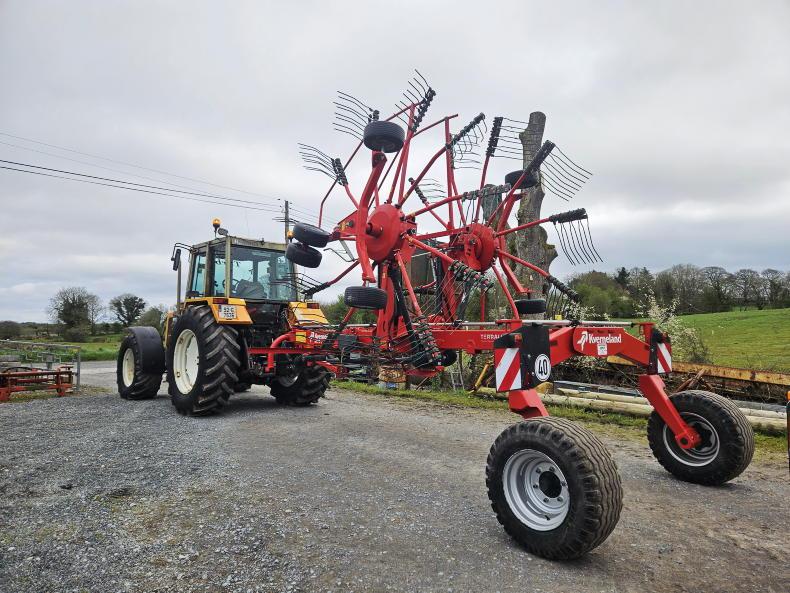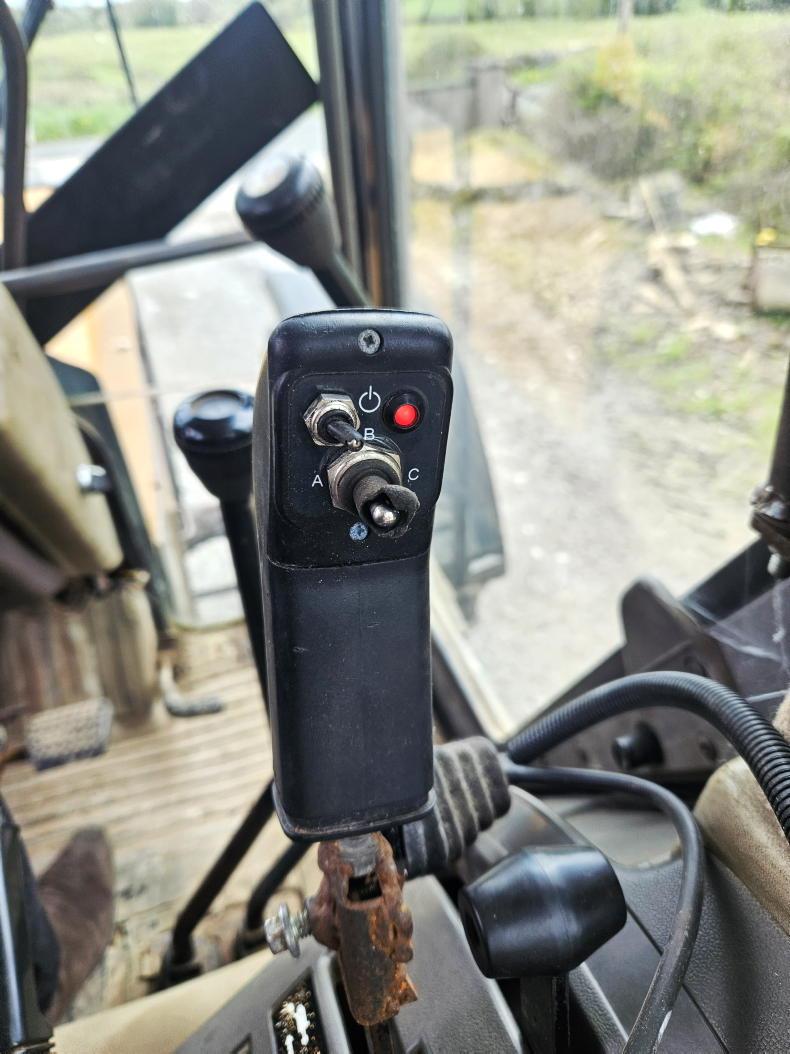A tractor mechanic by trade, Michael Hardiman runs an agricultural contracting business alongside his father Oliver.
Once he had completed his apprenticeship, Michael returned home to the family business. Based three miles from Athlone, the Hardiman family specialise in baling, slurry, reseeding and hedge-cutting.
Their first move towards raking silage ahead of the balers came in 2013 when they purchased a new Lely Rotunda. This was a mounted machine, which Michael explained had the capability of raking in two 10ft swaths.
He noted that it was well regarded by farmers locally for leaving a nice and fluffy, square ledge ahead of the baler. However, it was becoming tired from excess use and needed to be upgraded.
In 2018, a new trailed Kverneland 6472C twin-rotor rake was added and became the raking frontrunner in the fleet.
With an increased workload over the following years, the family decided that a second new rake was required, so decided to trade in the Lely Rotunda in 2020.
While keeping an eye out for a suitable replacement, the family spotted a new Kverneland 9464M, which is a mounted twin-rotor rake, in stock at D&E McHugh in Longford.

“Both rakes have the exact same mechanical setup, with both running oil-immersed cam discs and guide rollers."
Although a mounted twin-rotor rake isn’t mainstream, the family had previous experience with the concept, which worked out well for them, so they decided to carve out a deal for the new machine.
The Irish Farmers Journal understands that this is one of a handful of these rakes working in the country.
Why mounted?
“We work for a lot of small and part-time farmers, and the nature of the farms in this area tends to be small in size, and often with restricted access to yards and fields that tend to be off narrow roads.
“A mounted machine always had a place in our fleet. Quite a few of our farmer clients also tend to mow the grass themselves,” Michael said.
“The mounted machine is heavy on a tractor and has a huge tail swing.
"It can be awkward, but you will get it into places where you wouldn’t get the trailed rake into. Like with any mounted machine, if it fails to drive you in, you’ll manage to reverse it in the gap.

“The trailed machine pulls nicer on the road, can be operated with a smaller tractor and can hydraulically vary its working width."
“We find that an 80hp tractor would work away easily with the trailed rake, but you need more weight with the mounted rake. Typically, the smallest tractor we would run it on would be a 110hp Renault, with a front-end loader for that additional ballast.
“To get the very most from the mounted rake, we would typically follow the grass, which we cut with our 8ft trailed mower.
"We leave the corners as round as possible and find that the mounted rake will easily gather the three 8ft rows, leaving a really presentable swath for the baler.
“In terms of cornering, the mounted rake corners like a tedder. The headstock has some degree of movement to either side,” explained Michael.
Same workings
“Both rakes have the exact same mechanical setup, with both running oil-immersed cam discs and guide rollers.
"The only difference is that the mounted version has a working width of 6.4m, which is fixed in comparison to the trailed version, which has a 7.2m hydraulically variable working width.
“The trailed rake has an electric, controlled joystick that controls lifting both rotors individually, or simultaneously, from the cab. On the other hand, this wasn’t available on the mounted version, which was a shame. Both rakes have performed hassle-free for us.
“The only modification we asked for when we purchased the rake, before we put it to work, was to change the wheel guide setup, which runs under the rotors.

The trailed rake has an electric controlled joystick, which controls lifting both rotors individually or simultaneously from the cab.
"While reading up the machine specifications, we decided to go for the option of the tandem axle, which we felt would benefit the terrain that we work on.
"When taking it off, the mounted rake sits very neatly on four stands, two at the front and two at the rear,” Michael added.
“The trailed machine is our go-to machine, and this won’t change. It pulls far nicer on the road; it can be comfortably operated with a smaller tractor; we can hydraulically vary its working width and lift each rotor individually.
“However, the mounted rake definitely plays a role in the fleet and we won’t be moving away from one.

"When taking it off, the mounted rake sits very neatly on four stands, two at the front and two at the rear."
"It works in a lot of tricky places, where if a rake couldn’t fit in, the alternative would be to bale haybob’d ledges – and with the price of fuel, we don’t want to do that if we can help it.
"It’s a handy rake to put on and take off, and once you’re used to it, you’d fit it in any gateway. We will be keeping it for the foreseeable future,” concluded Michael.
A tractor mechanic by trade, Michael Hardiman runs an agricultural contracting business alongside his father Oliver.
Once he had completed his apprenticeship, Michael returned home to the family business. Based three miles from Athlone, the Hardiman family specialise in baling, slurry, reseeding and hedge-cutting.
Their first move towards raking silage ahead of the balers came in 2013 when they purchased a new Lely Rotunda. This was a mounted machine, which Michael explained had the capability of raking in two 10ft swaths.
He noted that it was well regarded by farmers locally for leaving a nice and fluffy, square ledge ahead of the baler. However, it was becoming tired from excess use and needed to be upgraded.
In 2018, a new trailed Kverneland 6472C twin-rotor rake was added and became the raking frontrunner in the fleet.
With an increased workload over the following years, the family decided that a second new rake was required, so decided to trade in the Lely Rotunda in 2020.
While keeping an eye out for a suitable replacement, the family spotted a new Kverneland 9464M, which is a mounted twin-rotor rake, in stock at D&E McHugh in Longford.

“Both rakes have the exact same mechanical setup, with both running oil-immersed cam discs and guide rollers."
Although a mounted twin-rotor rake isn’t mainstream, the family had previous experience with the concept, which worked out well for them, so they decided to carve out a deal for the new machine.
The Irish Farmers Journal understands that this is one of a handful of these rakes working in the country.
Why mounted?
“We work for a lot of small and part-time farmers, and the nature of the farms in this area tends to be small in size, and often with restricted access to yards and fields that tend to be off narrow roads.
“A mounted machine always had a place in our fleet. Quite a few of our farmer clients also tend to mow the grass themselves,” Michael said.
“The mounted machine is heavy on a tractor and has a huge tail swing.
"It can be awkward, but you will get it into places where you wouldn’t get the trailed rake into. Like with any mounted machine, if it fails to drive you in, you’ll manage to reverse it in the gap.

“The trailed machine pulls nicer on the road, can be operated with a smaller tractor and can hydraulically vary its working width."
“We find that an 80hp tractor would work away easily with the trailed rake, but you need more weight with the mounted rake. Typically, the smallest tractor we would run it on would be a 110hp Renault, with a front-end loader for that additional ballast.
“To get the very most from the mounted rake, we would typically follow the grass, which we cut with our 8ft trailed mower.
"We leave the corners as round as possible and find that the mounted rake will easily gather the three 8ft rows, leaving a really presentable swath for the baler.
“In terms of cornering, the mounted rake corners like a tedder. The headstock has some degree of movement to either side,” explained Michael.
Same workings
“Both rakes have the exact same mechanical setup, with both running oil-immersed cam discs and guide rollers.
"The only difference is that the mounted version has a working width of 6.4m, which is fixed in comparison to the trailed version, which has a 7.2m hydraulically variable working width.
“The trailed rake has an electric, controlled joystick that controls lifting both rotors individually, or simultaneously, from the cab. On the other hand, this wasn’t available on the mounted version, which was a shame. Both rakes have performed hassle-free for us.
“The only modification we asked for when we purchased the rake, before we put it to work, was to change the wheel guide setup, which runs under the rotors.

The trailed rake has an electric controlled joystick, which controls lifting both rotors individually or simultaneously from the cab.
"While reading up the machine specifications, we decided to go for the option of the tandem axle, which we felt would benefit the terrain that we work on.
"When taking it off, the mounted rake sits very neatly on four stands, two at the front and two at the rear,” Michael added.
“The trailed machine is our go-to machine, and this won’t change. It pulls far nicer on the road; it can be comfortably operated with a smaller tractor; we can hydraulically vary its working width and lift each rotor individually.
“However, the mounted rake definitely plays a role in the fleet and we won’t be moving away from one.

"When taking it off, the mounted rake sits very neatly on four stands, two at the front and two at the rear."
"It works in a lot of tricky places, where if a rake couldn’t fit in, the alternative would be to bale haybob’d ledges – and with the price of fuel, we don’t want to do that if we can help it.
"It’s a handy rake to put on and take off, and once you’re used to it, you’d fit it in any gateway. We will be keeping it for the foreseeable future,” concluded Michael.










 This is a subscriber-only article
This is a subscriber-only article










SHARING OPTIONS: